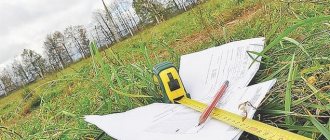For a long time, the owners of shares in the property of previously existing rural collective farms could not fully dispose of them. This was due to the imperfection of laws and registration: in fact, participants only received compensation in the form of “in kind” - grain, sunflower oil, flour, etc.
With the replacement of collective farms by joint-stock companies and other modern forms of ownership, shareholders now have the opportunity to fully decide what to do with their shared property - cultivate it themselves, rent it out, sell it, give it as a gift, or inherit it. In order to avoid mistakes that will later lead to losses, it is important to understand the nuances.
What it is
In Russia, such plots began to be allocated since 1991 in order to increase the number of private landowners. Land reform allowed many people to become owners of part of the land by registering it as their own property.
Many people are interested in the question of land share, what is it and what to do with it? A share does not refer to a plot of land with clear boundaries; it is only a right to a part of the land.
It has a size and a material assessment, but there is no identification of the site itself on the ground. Share lands can be provided for various purposes, but they are mainly intended for agricultural purposes . In this case, the interests of other shareholders must be taken into account.
Privatization of a land share into ownership is allowed. To obtain it, a certificate and the necessary cadastral documentation are drawn up, in the event that the owner of the share has decided to carry out the process of land surveying and allocating it for sale.
ATTENTION! Land plots can be sold, purchased, or rented out to generate passive income.
General concepts
It is necessary to distinguish a land share from the usual plot of private property. A share represents a part of common property , and the size is determined as a percentage of the total value of the plots, expressed in units of area.
Often, a share is included in the authorized capital of the interested organization (manufacturing enterprise, cooperative, joint-stock company), because the share was initially allocated during the period of transformation of Soviet farms and organizations into commercial enterprises.
When allocating a share, the principle of gratuitousness is applied, however, when determining who is entitled to the allotment, it should be noted that the right is used only by citizens directly associated with the collective farm or state farm from the lands of which the shares are formed.
In order to formalize the right to an allotment, it is necessary to go through the privatization process, on the basis of which the new owner will be registered and registered according to the Cadastre. If you intend to physically allocate an allotment, you need to find out how to obtain new documents, because the owner of the share will have to go through a lengthy procedure associated with surveying and registration of boundaries, assigning a cadastral registration number and issuing a cadastral passport.
The current situation is that only half of the lands are shares united together, the owners of which have successfully transferred ownership to themselves.
In other words, the land share is presented in the form of a certain amount of land area per person, without separation from the total number and without defining specific boundaries. The documentary basis for considering oneself a holder of a share of agricultural land is a certificate establishing the right to common ownership.
The supporting document includes the following information:
- share size;
- assessment in point-hectares;
- type of land use (for arable land, pasture, etc.)
The peculiarity of such a right is the averaging of characteristics and attribution to virtual property, which can, if desired, be received in the form of property.
Share allocation
To carry out the procedure for allocating a share, you first need to draw up a plan:
- The land surveying scheme is approved at a general meeting of owners.
- It is necessary to obtain a conclusion issued by the land committee of the municipality that the norms of land legislation have not been violated.
- A cadastral passport must be issued for the allocated share plot.
The remaining shareholders should be aware that the land plot is being prepared for formation. You can do this by spreading the word through your local newspaper. The notice is submitted one month before the start of land management work.
Taxation
All transactions related to the registration of a land share provide for mandatory taxation. The amount of tax is calculated according to the cadastral value of the land and cannot be less than 1000 rubles.
The Federal Tax Service in a particular region or municipality is responsible for notifying all land owners about paying taxes.
Those owners of shared lands who rent out plots and receive profit from this are considered official taxpayers and are required to pay taxes in accordance with Article 226 of the Tax Code.
Persons who use land for personal purposes, conduct agricultural activities on it, and do not rent it out, are also required to pay taxes, taking into account the relevant articles of the Tax Code of the Russian Federation.
The deadline for paying land tax for the past annual period is November 1 of this year.
How to purchase
A share of a land plot can be purchased without carrying out the necessary work. It is enough to indicate in the contract the size of the share, information about encumbrances (if any), including the deadline for transferring the land share. The contract must be accompanied by a diagram of the plot of land, without marking the boundaries.
ATTENTION! It is most profitable to purchase a dedicated plot of land with already marked boundaries, its own plan and cadastral value.
You can receive an allotment in several ways:
- Buy.
- Receive an inheritance.
- Receive as a gift.
There are situations when a person wishing to purchase shared land is not aware of its exact location. How to find out where the site is?
To find out the coordinates of the plot and its boundaries, you need to contact a cadastral specialist (engineer) at the location of the land plot. Based on data from the cadastral authority, he will accurately identify a plot of land with reference to its location.
Legislation
The legal framework regulating agricultural land shares and containing laws is as follows:
| action | what is regulated |
| process of providing allotments | Federal Law No. 101 of 2002 “On the turnover of agricultural land” |
| appeal to the state cadastre | Federal Law No. 221 of July 24, 2007 “On the State Real Estate Cadastre” |
| registration of title documentation | Federal Law No. 122 “On state registration of real estate and transactions with it” |
Price
The cost may depend on various factors and parameters. If a share of land is purchased for construction work, then the main criterion that will determine the price of the share is the location of the site. If it is located outside the city, then its cost will be much higher.
If a share is purchased for further agricultural use, then the cost will be determined by the following factors:
- The total area of the land plot.
- How fertile is the soil?
- Distance from infrastructure.
The average price of a share plot ranges from 50 to 250 thousand rubles per 1 hundred square meters. The shareholder has the right to sell his share at any established price.
It is important to consider one point.
By law, if the owner of a land share decides to carry out a transaction to sell it, he must notify the municipality about this, since he has a pre-emptive right to purchase.
The owner of the share must submit a written request to the local administration indicating the size of the share, its location, and cost. If this condition is not met, then all further transactions will be illegal.
If the municipality refuses the purchase or does not respond within three months, the share can be sold to others. In this case, the price of the object should not be less than what was indicated in the letter. Otherwise, a fine may be imposed on the owner or the transaction will be considered invalid.
Allocation and privatization
Since an agricultural land share is only a right, in order to privatize an object, it must first be separated from the general agricultural territory into an independent one. Therefore, the registration procedure will be more complex and lengthy than the usual registration of land ownership. You can do this either independently or with the help of a lawyer.
Announcement in local media
You need to start the event by submitting an advertisement in the local newspaper. The text must contain information about yourself and the purpose of highlighting your land share from the general territory. It is important that the newspaper is distributed throughout the entire area where the village is located. You need to contact the editorial office - it is located in the regional center.
The same announcement must be duplicated on the Internet resource of the local government body. To do this, you need to send a written notification to the administration, which contains the date, time, place of collection and its purpose.
Meeting of shareholders
A month must pass after the announcement is released. The next stage will be organizing a meeting where the remaining shareholders of the territorial unit (village) must be present.
Stages:
- You can gather residents using a notification on the local bulletin board. The purpose of the meeting is to determine the boundaries and area of the future land plot. The venue can be the building of the local rural administration (village council).
- A representative of the local administration must be present at the gathering - he checks the registration procedure (everyone must have their passports and certificates of shares with them). He is also the chairman of the meeting.
- It is necessary to appoint a secretary who will register the participants and draw up a protocol.
- Next, a proposal on the parameters of the site is submitted for general discussion. After this, a vote is held, during which the secretary counts the number of those who agree and those who protest. The advantage remains with the answer accepted by the majority.
- The result is calculated in two ways - by comparing shares or by ordinary counting of votes (if the first option is not possible).
- At the end of the event, minutes of the commission meeting are drawn up.
- The decision must be signed by all those present and the chairman. This document will be the basis for the selection. The paper is considered valid if at least half of all shareholders have participated. If not enough villagers came, a repeat quorum is organized - according to a similar scheme.
The protocol must contain the following mandatory points:
- Date and venue.
- The agenda is the subject of discussion.
- Result of the meeting.
- An application that contains a list of participants, their passport details and details of share documents. Signatures are placed here, opposite the data.
- Signatures of the chairman, organizer of the meeting and secretary.
The document is drawn up in two copies - one remains in the archives of the village council, the other is transferred to the initiator of the event. The paper is kept in the village council - anyone interested can apply for it within three days after the vote. An authorized person issues a copy or an extract; the cost of printing is paid by the recipient.
Loading…
Too long?
Reload document
| Open in new tab
Surveying
The next stage, which is the most expensive, is the land surveying procedure. Order of conduct:
- With the signed minutes of the meeting and a certificate of share rights, you need to contact the local Cadastral Service to call an engineer for measuring work.
- A contract agreement is concluded with the executive, which specifies the nature of the service, the object and the final cost of the work. The latter is also stated in the estimate, which is attached to the document.
- To perform the service, a specialist needs to visit the site - based on the results of satellite imagery, he determines the coordinates of the characteristic points of the site. Next, the boundaries are designated and the area is calculated.
- Based on the results of measurements, a boundary plan is drawn up, where the physical characteristics of the plot are recorded. Based on it, a cadastral plan is drawn up - the final display of the territory’s data.
In most cases, in rural areas there is one specialized surveying company. If there are several of them, the quality of the work may be different, so when choosing a contractor you must be guided by recommendations and reviews.
It is important to check that the company has a special license for land surveying. The procedure is paid - tariffs for each locality are different and are clarified by the authorized organization. Documents confirming payment must be retained.
Coordination and cadastral plan
The resulting boundary plan must be agreed upon with other shareholders of the local settlement, because they are potential neighbors. For this purpose, a general meeting will be organized again, where the agenda will be the approval of the survey project. Peculiarities:
- In order for the quorum decision to have legal force, the presence of at least 20 percent of the total number of shareholders must be present.
- If everyone’s shares are different, the number of those present is determined by calculating the share size - at least 50 percent of the total territory must participate.
- The course of the meeting is similar to the gathering, where the owners express their consent to the allocation of land.
- The protocol will be valid if, in addition to the participants, a representative of the local government and the secretary of the meeting put their signatures. The list of voters is drawn up in the form of an appendix indicating their passport data.
- The previously generated boundary plan and other documents collected so far are attached.
Copies of documents are kept in the local village council; interested parties can receive them for review within three days after the meeting.
With the land management file (package of documentation), you must contact the Land Committee - an authorized person will approve the boundaries of the territory on the ground, create a boundary file and issue a cadastral plan with a detailed drawing. The result of the survey can be appealed to the same authority.
Registration in Rosreestr and obtaining a certificate
The final stage is registration of the formed allotment in the Russian Register. Before you write an application and submit documents, you need to pay a state fee. You can contact Rosreestr through the Multifunctional Center. Papers that must be submitted for registration:
- Passport of a citizen of the Russian Federation.
- A statement according to which the right to a land share must be formalized as land ownership.
- Cadastral plan.
- Protocol of agreement with shareholders.
- Certificates confirming the absence of debt to the tax authorities and seizure of property rights.
- An appraisal document establishing the value of the plot.
- Receipt for payment of state duty.
After submitting copies of documents, you must obtain a receipt from the MFC employee. Before this, he checks the copies with the originals. The period for issuing a certificate of ownership is about a month.
It is possible to send documents by mail - the recipient will be the local branch of Rosreestr. In this case, it is necessary to draw up a registered letter with an inventory. Compared to MFC, the method is much less popular.
Owner's rights
The received document gives full right to use and dispose of real estate at your own discretion - sell, give, inherit. It is worth noting that the type of permitted use in this case will be farming, but not individual residential construction.
The latter is possible only when changing the VRI - for this you need to contact the local administration with a corresponding application, to which either a positive or negative answer can be given.
Therefore, the land can only be used for planting or raising animals. Article 78 of the Land Code of the Russian Federation also allows the creation of artificial ponds for fish breeding or forest plantations on such plots.
Responsibilities
In addition to the rights, the owner of the allocated territory has the following responsibilities:
- Pay land tax annually. This issue is regulated by Chapter 31 of the Tax Code of the Russian Federation.
- Operate the plot within the framework of the land category and type of permitted use.
- Prevent its desolation, damage to the quality of the soil, its depletion and destruction.
- Do not pollute the environment.
- Maintain boundary signs placed on the square.
- Observe fire safety measures.
- If you have neighbors, respect their rights.
In case of violation of duties, the owner may be fined or the property may be confiscated for the benefit of the local municipality.
Decor
ATTENTION! In order for shared land to be recognized as the property of its owner, it is necessary to undergo state registration.
To acquire the status of owner of a land share when purchasing it, you will need to draw up an agreement on the completed transaction . Next, you need to provide the registration authorities with the following documents:
- Copy of the passport.
- Consent of the spouse to conduct the transaction, which is notarized.
- Authority to use the land share.
- Statement.
- A document confirming payment of the state duty.
- Copies of notifications to other shareholders about the planned sale of the site, as well as confirmation of their sending.
After providing all the necessary papers, the Rosreestr employee issues a receipt indicating the list of documents received, the date and time of applying for documents that will establish the right to share land.
The next step will be to allocate a share of land in the area . For this purpose, an application is submitted to the management of the agricultural enterprise. The document indicates the size and location of the share. Then the area is surveyed. In general, the entire procedure for registering ownership rights to a share plot takes from 1 to 2 months.
Refusal to register a land share
Reasons
When reviewing documents, the municipal authority has the right to suspend registration by appropriate decision. The applicant is given a period of no more than 30 days to eliminate the reasons preventing the emergence of proper rights. The reasons can be reduced to 3 main areas:
- failure to submit required documents (for example, a land survey plan or a power of attorney for a representative);
- providing false information;
- incorrect filling out of the application or lack of a signature on it.
When the reasons for the suspension are not eliminated, the state body refuses to register the right to a land share.
Useful to know: How to formalize a waiver of the right to a land plot.
Appeal to the commission
The first instance for appealing a refusal to register a land share is the appeal commission under the authorized body where the refusal was issued. You must appeal the decision within 30 days from the date it was received.
To apply, you must fill out the form and attach copies of documents. The application is considered by the commission within 1 month. If the decision to refuse registration of a land share remains unchanged, a repeated application is not allowed.
Challenging in court
After a refusal by the appeal commission, you can appeal the decision only by appealing to the arbitration court. Procedural periods, as a rule, do not exceed 3 months. To go to court, you must prepare a statement of claim in 3 copies, attach copies of documents and send it to the court at the location of the property.
How to dispose
The owner of the allocated land share has the right to dispose of it at his own discretion, if these actions do not violate the norms of land legislation. The main transactions performed may be:
- Purchase or sale of shares.
- Exchange for other property.
- Rental. A lease agreement can be concluded for any period of time and must be registered with a government agency if the transaction period is more than 1 year. The payment for the leased share is established by both parties by agreement and cannot be changed unilaterally.
- Give for use.
- Pawn.
- Give or inherit as a gift.
Most often, a share is rented out or given for temporary use in order to make a profit. It can also be used as the authorized capital of a legal entity (joint stock company, as well as a consumer or production cooperative).
IMPORTANT! Registration of a share, as well as transactions made with it, are subject to taxation, the amount of which depends directly on the cadastral value of the plot. Moreover, its value should not be less than 1000 rubles.
Owner rights
If the allotment is part of the common property of the shareholders, then the owner’s rights are limited:
- will;
- waiver of property rights;
- adding land to the share capital of an agricultural organization;
- transfer to trust management to another shareholder;
- sale or gift to a shareholder.
If the owner allocates land from the general area, then the range of his rights expands and he has the right:
- Conclude purchase and sale transactions of land.
- Exchange for other real estate.
- Rent out.
- Pass on by inheritance or as a gift.
- Pawn it in a bank.
- Donate.
Advantages and disadvantages
The main advantage of a share plot is the opportunity to receive a constant income from it. This can be money received both from the sale of grown agricultural products and from completed transactions.
The negative side is its mandatory taxation, poor harvest or no harvest at all, as well as unscrupulous tenants, which can lead to loss of profit. According to the law, the state can forcibly take away a land share if it is used for other purposes or is not legally registered.
Who buys them
Land shares have the right to receive:
- Members of collective or state farms.
- Residents of rural areas - once.
- Heir of a member of an agricultural enterprise.
- Social workers working in agricultural enterprises.
Important! If, after three years of ownership of the share plot, it has not been used for its intended purpose, then the local municipality authorities have the right to seize it and recognize the share as ownerless.
The process of issuing shares was completed in 1998 , but it is possible to become its owner through a civil transaction.
How to buy shared property correctly?
You can buy a land share according to the standard purchase and sale scheme. First of all, you need to remember that a land share cannot be purchased with a change in purpose; there are restrictions on the size of the plot for the owner within the municipality. Priority right to purchase from neighboring shareholders and administration.
Before signing the contract, you need to carefully study the documents on the plot itself and on the owner’s right to alienate the land:
- There should be no documents or facts confirming the “dark past” of the site: misuse, soil degradation, littering, etc.
- Does the site have any encumbrances (extract and Unified State Register);
- Confirmation that the owner offered the purchase to the municipality or neighboring shareholders; only after this is a free sale possible: the price should not exceed that established before permission;
- Certificate of state registration;
- Foundation agreement;
- Extract from the cadastral passport;
- If there are buildings on the site - an extract and BTI for each of them are required
- Spouse's permission, if you have one.
Next, a purchase and sale agreement is drawn up, which contains:
- Information about the seller and buyer;
- Information about the site;
- Transaction cost.








